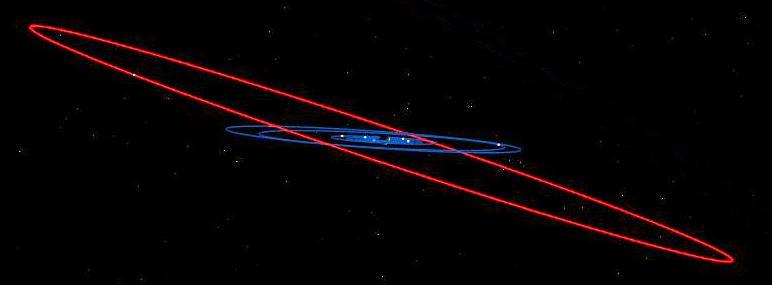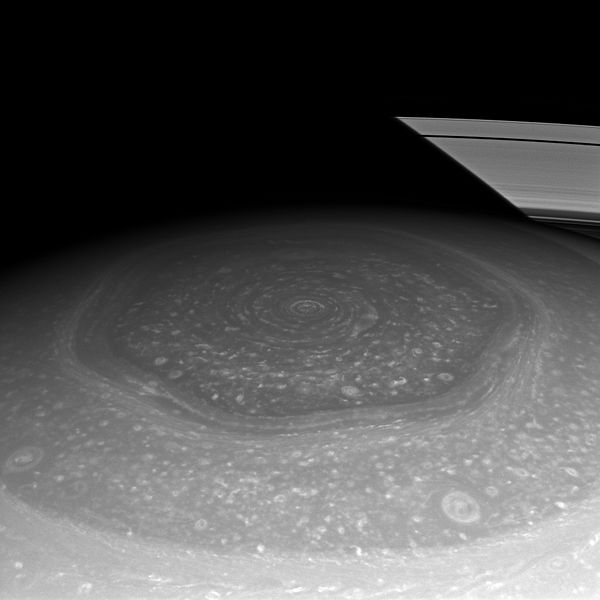
Saturn through a very small telescope. Photo by Thomas King, 2006 February 19.
Scientific fashions change. In the early 1800s, "intelligent design" was mainstream science. Most people today no doubt realise this, but attribute it to the religious temper of the times; few recognise that "mainstream science" then was as serious as it is now. Nor do many recall that intelligent extraterrestrials also figured in the Nineteenth-Century paradigm of the solar system ...

Saturn through a small telescope. Photograph by Thorsten Moortz, 2005 April 2.
From On the Planet Saturn by M. Smith [Philosophical Magazine 67, 57 (1826)]. Smith's words are in bold.
To the Editor of the Philosophical Magazine and Journal.
Sir,
... A very curious subject for speculation, which does not appear to have hitherto suggested itself to the inquiry of astronomers, is the following :
What is the use of this stupendous ring, which for extent of surface and solidity of structure (as we may infer from its superior brightness) surpasses even the planet itself?
Can it be a habitable world ?

Saturn, rings, shadow, and hurricane. Natural-colour view from the Cassini spacecraft, 2010. [NASA]
Certainly it may; for the velocity with which the ring revolves on its axis may be so adjusted as to produce a centrifugal force which shall be an exact counterpoise to the force of gravity towards the planet: and in such case the surface of the ring must appear to the annularians [inhabitants of the ring] as a horizontal plane; while the body of the planet is seen in the distance like an immense mountain, behind which the sun disappears for about one or two hours (according to circumstances) out of every ten hours, or one revolution of the ring.
The edges of the ring are probably rounded off, although our instruments will not enable us to verify this fact by observation ; and in such case the annularians may travel either by land or water from one surface of the ring to the other without observing any remarkable appearance, except that on passing round the edge of the ring the heavenly bodies will change their altitudes rapidly within a comparatively small space.
To those who may be on the inner edge of the ring the body of the planet probably appears as a circular plane directly over their heads, and supported by two great pillars rising from opposite points of the horizon. The satellites of Saturn are probably never seen by the annularians, except by those who may be near the outer edge of the ring ; for as they revolve in the plane of the ring, they are always in the horizon : the seventh satellite [Iapetus -- in 1825, Hyperion had not yet been discovered] is, perhaps, an exception ; for as it deviates from the plane of the ring, it may occasionally appear a few degrees above the horizon.

The steeply inclined orbit of Iapetus. Drawing by "Singing Badger".
It has been conjectured by some who have thought but slightly on the subject, that the ring was constructed for the purpose of enlightening the planet in the absence of the sun. To those who advance this opinion it may be replied, that for the purpose of illumination the ring is worse than useless, inasmuch as that it intercepts more of the sun's light from the planet than it reflects towards it.

Simulated view of the rings of Saturn, as seen from a position high in Saturn's atmosphere. Four moons are also visible. Image by "Singing Badger", 2004.
To exemplify this let us assume any particular spot on the surface of Saturn. Suppose a spot whose latitude is equal to that of London. Now by duly considering that the plane of the ring is inclined thirty degrees to the plane of Saturn's orbit, it will be perfectly evident, that to the assumed spot the ring can only appear enlightened by the sun during one half of the year, and that the summer half ; to which may be added, that all the portion of the ring which at midnight is near the meridian, must be eclipsed by the body of the planet. The phænomena actually observed will therefore be as follows ; viz.
Immediately after sunset an arm of the ring will appear in the west, which will gradually shorten and finally set; but before it entirely disappears, another similar arm will rise in the east, and gradually lengthen until the superior brilliance of the ascending sun supersedes its use as an object of illumination. About the period of the summer solstice these two arms of the ring will unite so as to form an entire arch intersecting the horizon in the east and west, and inclined thereto at angle equal to the co-latitude of the place, at which time there will certainly be considerable illumination. Still it may be remarked that the illumination is most perfect when least wanted.
This therefore, as well as the fact that the planet is furnished with seven moons, is demonstrative proof that the ring was not constructed for the purpose of illumination ; and no other supposition remains than that it was formed to be a habitable world.

Illumination of Saturn and its rings, as photographed in natural colour 2007 January 19 by the Cassini Orbiter, at a distance of only 1.23 million km. [NASA]
It may further be remarked that although the ring cannot usefully enlighten the planet, yet the planet reflects a very strong light on the ring for about half of each period of ten hours; and therefore the annularians have no reason to regret that the satellites do not rise above their horizon, because the planet reflects them, perhaps, ten times more light than would be the united effect of all the satellites.

Small-telescope photograph by Rochus Hess, © 2004 March 27, showing the Cassini division.
The ring of Saturn is now known to be double, or to be in fact two concentric rings ; but this circumstance does not affect the justness of any of the foregoing arguments. Perhaps this division may be advantageous to the inhabitants, as affording them a short cut from one surface of it to the opposite ; or perhaps the adjustment of centrifugal force before alluded to, may require that the velocity of rotation should in a small degree differ in the two rings, in order to produce an equilibrium, or counterpoise to the force of gravity towards the planet; for unless this equilibrium be effected, the surface of the ring could not appear to the inhabitants perfectly horizontal.

The rings almost edge on, with the moons Janus and Prometheus, photographed by the Cassini Orbiter 2006 April 29.
It has been remarked by Sir William Herschel, that "the ring of Saturn reflects more light than the body of the planet." The natural inference is, that it is formed of materials of greater specific density; and it seems advantageous that it should be so : for otherwise, on account of its comparative thinness, it could not produce an adequate force of gravity perpendicular to its surface, which we must suppose essential to its being inhabited.
The annularians in their systems of geography can only estimate their latitude by the observed altitude of Saturn's pole ; for the sun and all the other heavenly bodies have the same altitude viewed from every part of the flat surface of the ring. As for their longitude, I have not hitherto been able to decide how they ascertain it.
Should the foregoing remarks be thought to merit a place in your Journal, the insertion will much oblige, sir.
Your most obedient servant,
M. Smith.
Nov. 17, 1825.

The North Pole of Saturn with its strange hexagonal vortex, viewed by the Cassini spacecraft from a distance of 649000 km. The bright object at upper right is the ring, sharply cut off by the planet's shadow. [NASA]